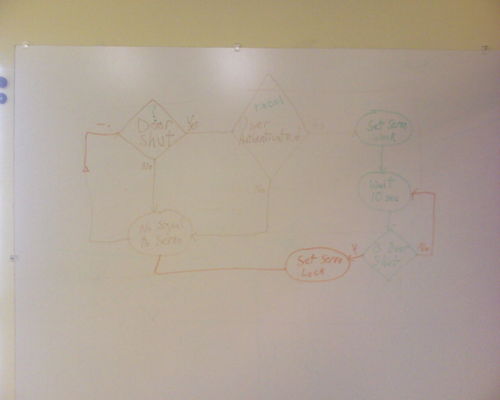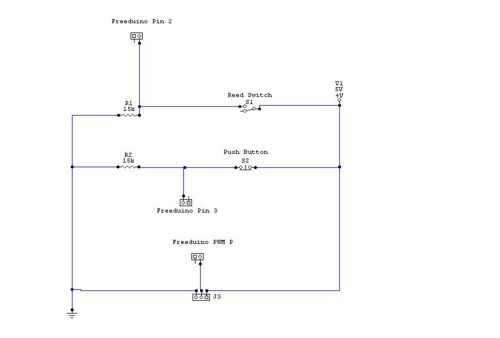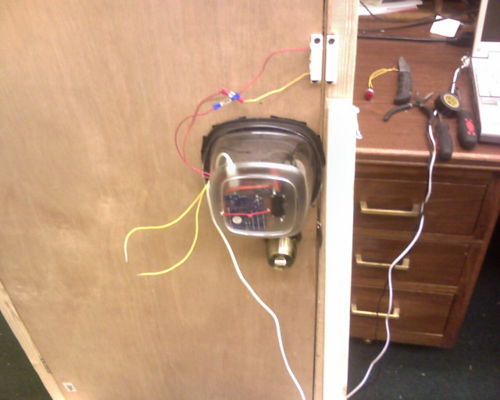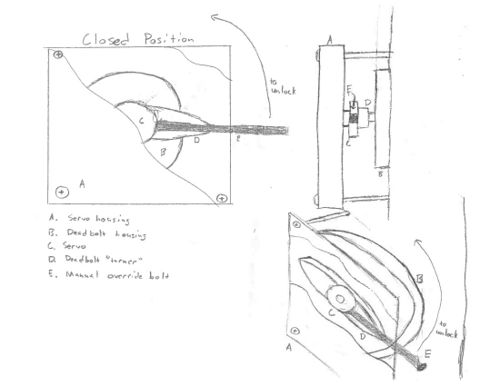USB Auth
Contents
[hide]Video Demonstration
Here's the video of the project:
http://www.youtube.com/watch?v=JKTXRlaXLDQ
Concept
A computer will monitor for new USB devices being plugged into the system. If the device is on the approved list, it will instruct an external system to unlock a door.
Implementation
Authentication Flow
- User inserts key into USB hub hooked to a PC
- Computer reads serial ID of key
- Computer compares serial ID to list of valid serial ID in a table \ DB \ Flat File
- If good, computer writes data ("Unlock!") to USB line of Microcontroller
- Microcontroller instructs servo to go to unlocked position for 5-10 seconds.
The flowchart for the circuit is below.
Parts List
- Servo $12
- Tubberware $6
- Freeduino Development Board $36
- Breadboard $5(?)
- Solder, Soldering Iron (On Hand)
- 15k Ohm Resistors (On Hand)
- Button (On Hand)
- Powered USB Hub ? (Necessary: for powering Freeduino with only USB and a laptop)
- Unpowered UBS Hub (Optional: Hub to put outside of door to plug USB keychains into)
Electrical Interface
Electrical Interface by Omegix
Note: "Freeduino PWM Pin P" Should be "Freeduino PWM Pin 9"
The resistors here are just pull down resistors.
The reed switch is one of those window sensors commonly found in home security systems.
The push button is for the inside of the door so people can unlock the door to get out.
Pin 9 is the for the Servo signal.
Mechanical Interface
Mechanical Interface design by Gregabyte
Project Enclosure
We wanted a project enclosure that we could easily take on and off the door. Also we wanted something that was firm and see-through so people could see the project in action. Tupperware! Thank you, Rubbermaid.
Mechanical Override
Note: Mechanical override will not be implemented till after Phreaknic Omegix 14:58, 21 October 2008 (CDT)
The idea here is to have a servo attached to a standard deadbolt. The microcontroller will need to not only receive a signal from the computer, but also sense a window-open detector, and control a servo.
If you were to attach the stick to the deadbolt turner or the plastic connected to the servo motor shaft, that would allow for a manual unlocker for the door in the event of a power failure
This image from Gregabyte shows a mechanical override system that could be implemented for under $20
Code
USB Reader Code
Coded by Brimstone
#!/bin/sh
# variables!
mymu=A6005ycb
mydev=/dev/ttyUSB0
mydb=usb-keys.txt
# first, define some common functions
function lsserial {
lsusb -v | awk '/iSerial/ {if ($2 == "3" || $2 == "2") {print $3}}'
}
# figure out whats attached
# check for our microcontroller
if [ $(lsserial | grep -c $mymu) = 0 ] ; then
echo -n "I don't see the microcontroller "
if [ -e $mydev ]; then
echo "but we have a $mydev ?"
else
echo
fi
exit 1
else
if [ ! -e $mydev ]; then
echo "I see the microcontroller, but no $mydev"
exit 1
fi
fi
if [ -e $mydb ] ; then
echo "Found serials for the following people:"
awk -F, '{print $1}' $mydb
else
echo "Didn't find keyfile $mydb"
exit 1
fi
# all good, lets go
preserial=$(lsserial | grep -v $mymu)
if [ -n "$preserial" ]; then
echo "I've detected the following serial devices already:"
echo $preserial
fi
echo "Ready and waiting"
# main loop that watches /var/log/messages
(
tail -n 0 -f /var/log/messages | awk '/new.*USB device/ {print "Attached"; fflush()} /USB disconnect/ {print "Dettached"; fflush()}'
) | (
# main loop that reads that cleaned /var/log/messages
while read cmd; do
if [ $cmd == "Attached" ] ; then
for ser in $(lsserial | grep -v $mymu); do
echo "Checking for $ser in flat file"
if [ $(grep -c $ser $mydb) = 1 ]; then
name=$(awk -F, "/$ser/ {print \$1}" $mydb)
echo "Unlocking for $name!"
echo -n U > $mydev
error=$?
if [ $error != 0 ]; then
echo "There was an error ($error) writing to $mydev"
fi
else
echo "Didn't find it in flat file"
fi
done
else
echo "Got $cmd but nothing implemented for it"
fi
done
)
Freeduino Code
Coded by Omegix
#include <Servo.h>
#define interrupt1PinA 3
volatile unsigned int interrupt1Value = 0;
char incomingChar = 0;
Servo myServo;
int pos;
int DoorSensePin = 2; //this is the PIN that the reed switch is connected to
int lockedPosition = 115; //This is the value that the servo wants to be at the correct physical position
int unlockedPosition = 28; //This is the value that the servo wants to be at the correct physical position
boolean HasForceUnlockHappened = 0; //this is used by the interrupt routine as a workaround to using timers
void setup()
{
Serial.begin(9600);
Serial.flush();
myServo.attach(9); // attaches the servo on pin 9 to the servo object
Lock(); //default to locked position at powerup
//myServo.write(28); //default to locked at powerup
pinMode(DoorSensePin, INPUT); //designate pin2 as a sensing (input) pin
pinMode(interrupt1PinA, INPUT);
attachInterrupt(1, ForceUnlock, HIGH); //when interrupt happens, run ForceUnlock function
}
void ForceUnlock() //it is important that no timer related functions happen during an interrupt routine
{
Serial.println("Force Unlock Button Pressed! Interrupt Called!");
myServo.write(unlockedPosition); //cannot call regular Unlock function as it has a delay() call
HasForceUnlockHappened = 1;
}
void loop()
{
//Serial.println("In Main Loop"); //TROUBLESHOOTING LINE
if (HasForceUnlockHappened == 1) //if an interrupt driven ForceUnlock has happened, then need to WaitToLock
{
HasForceUnlockHappened = 0; //reset till next interrupt
WaitToLock();
}
if (Serial.available() > 0)
{
incomingChar = Serial.read();
Serial.print("I recieved: ");
Serial.println(incomingChar, DEC);
//Serial.print("The DoorSense Value is: ");
//Serial.println(IsDoorOpen(), DEC);
// Code for Unlocking Door. Unlock does not care if door is closed or not.
if (incomingChar == 85) //"U" is 85 in DEC. U is for Unlock
{
Serial.println("Unlocking!");
Unlock();
}
//Code for Locking Door. Lock cares if door is open or closed.
if (incomingChar == 76) //"L" is 76 in DEC. L is for Lock
{
if (IsDoorOpen() == 0)
{
Serial.println("Locking!");
Lock();
}
if (IsDoorOpen() == 1) { Serial.println("Door is Open!!"); }
}
}// if serial end
}//loop end
//IsDoorOpen should return a 1 if Door is Open, and a 0 if Door is Closed.
boolean IsDoorOpen()
{
if (digitalRead(DoorSensePin) == 1) { return 1; }
if (digitalRead(DoorSensePin) == 0) { return 0; }
}
void Unlock()
{
myServo.write(unlockedPosition);
delay(100);
WaitToLock();
}
void Lock()
{
myServo.write(lockedPosition);
}
//This function will loop until the door is closed for 5 seconds and then Lock.
void WaitToLock()
{
BeginWaitingToLock:
while (IsDoorOpen() == 1) { /* Serial.println("Door Needs to Close."); /* do nothing */ }
//At this point Door should have shut
Serial.println("Door has been shut! Waiting 5 seconds.");
delay(1000 * 5); //wait 5 seconds
if (IsDoorOpen() == 0) // if door is still closed after delay, then lock
{
Lock();
}
if (IsDoorOpen() == 1)
{
Serial.println("Door Did not remain shut. Starting over loop.");
goto BeginWaitingToLock;
}
}



